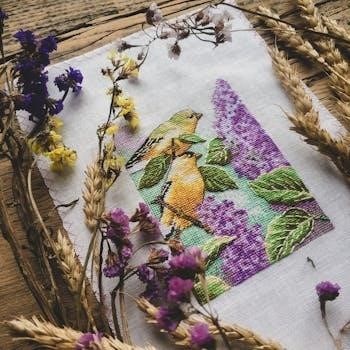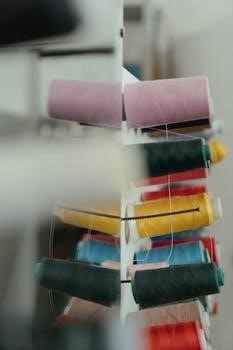Needlepoint Stitches PDF⁚ A Comprehensive Guide
Embark on a journey through the captivating world of needlepoint with our comprehensive guide! This resource provides a detailed overview of needlepoint stitches․ From basic techniques to advanced patterns․ Downloadable PDF format ensures easy access․ Perfect for both beginners and experienced needlepointers!
Needlepoint, a timeless craft, involves creating decorative designs on canvas using a variety of stitches․ This guide delves into the fundamentals of needlepoint, starting with an introduction to the craft itself; Needlepoint offers a relaxing and creative outlet, allowing you to transform plain canvas into beautiful works of art․ We will explore the essential materials needed, including canvas, yarn, needles, and scissors, and how to prepare your canvas for stitching․
Furthermore, we’ll introduce you to the basic stitches that form the foundation of needlepoint․ These include the tent stitch family, encompassing the continental, basketweave, and half-cross stitches․ Mastering these basic stitches is crucial for creating a solid and even base for your needlepoint projects․ Each stitch will be explained with clear diagrams and step-by-step instructions, ensuring that even beginners can grasp the techniques easily․ Understanding these foundational stitches will empower you to tackle more complex designs and decorative stitches as you progress in your needlepoint journey․ So, gather your supplies and prepare to embark on a rewarding and creative adventure into the world of needlepoint!

Understanding Tent Stitches
Delve into the world of tent stitches, the cornerstone of needlepoint! Discover the variations⁚ Continental, Basketweave, and Half-Cross․ Master these essential techniques to create a solid foundation for your needlepoint projects, ensuring beautiful and durable results․
Continental Stitch⁚ Technique and Uses
The Continental stitch, a foundational technique in needlepoint, is celebrated for its versatility and robust coverage․ This stitch, a variation of the tent stitch, is worked diagonally across the canvas, creating a sturdy and reliable surface, ideal for areas requiring durability and consistent color․ Its diagonal nature makes it perfect for filling in backgrounds or creating solid blocks of color in your needlepoint designs․
To execute the Continental stitch, bring your needle up through the canvas and then down diagonally to the right, repeating this sequence across the designated area․ While relatively simple to learn, it’s crucial to maintain consistent tension to prevent distortion of the canvas․ This stitch is particularly useful for smaller projects or areas where a quick and easy fill is needed․ However, it’s worth noting that the Continental stitch can sometimes cause canvas distortion due to the way the thread pulls, especially in larger areas․ Despite this potential drawback, its ease of execution and strong coverage make it a valuable addition to any needlepointer’s repertoire․
Basketweave Stitch⁚ Technique and Uses
The Basketweave stitch is a beloved technique in needlepoint, known for its exceptional canvas coverage and resistance to distortion․ Unlike the Continental stitch, the Basketweave is worked in alternating rows of horizontal and vertical stitches, creating a pattern that resembles a woven basket․ This unique construction distributes tension evenly across the canvas, preventing it from pulling out of shape, making it ideal for larger projects or areas requiring significant filling․
To execute the Basketweave stitch, begin in a corner and work diagonally across the canvas, alternating between going over two canvas threads and under two canvas threads․ On the return row, reverse the pattern․ This creates a woven effect on the back of the canvas, adding to its durability․ The Basketweave stitch is a bit more time-consuming than the Continental stitch, but the resulting even tension and professional finish make it well worth the effort․ Its robust nature makes it perfect for items that will be handled frequently, such as pillows, bags, or upholstery․
Half-Cross Stitch⁚ Technique and Uses
The Half-Cross stitch is one of the simplest needlepoint stitches․ It is often recommended for beginners due to its ease of execution․ However, it’s essential to understand its limitations before using it extensively․ The Half-Cross stitch involves bringing the needle up on the lower left of a canvas intersection and down on the upper right․ This creates a diagonal stitch that resembles half of a traditional cross stitch․
While easy to learn, the Half-Cross stitch doesn’t provide the best canvas coverage․ This can lead to the canvas showing through, particularly with lighter-colored threads․ Additionally, it exerts uneven tension on the canvas, which may cause distortion over time․ Therefore, the Half-Cross stitch is best suited for small areas or for projects where durability and complete coverage are not critical․ It can be useful for adding subtle details or for filling in small gaps of color․ Given its drawbacks, many needlepointers prefer the Continental or Basketweave stitch for larger areas․

Decorative Needlepoint Stitches
Elevate your needlepoint projects with decorative stitches! Explore a diverse range of techniques beyond basic stitches․ Add texture, dimension, and visual interest․ Unleash your creativity and transform your needlepoint into a masterpiece․ Discover the beauty of decorative stitches!
Exploring the Scotch Stitch
The Scotch stitch is a versatile and visually appealing needlepoint stitch that adds texture and dimension to your projects․ It’s known for its distinctive block-like appearance, created by diagonal stitches worked in a specific sequence․ This stitch is excellent for filling in small to medium-sized areas, creating geometric patterns, or adding a touch of visual interest to backgrounds․
The Scotch stitch is relatively easy to learn, making it a great choice for both beginner and experienced needlepointers․ Its repetitive nature allows for rhythmic stitching, while its unique texture adds a professional touch to your work․ Experiment with different thread colors and weights to achieve a variety of effects․
Consider using the Scotch stitch to create eye-catching borders, geometric designs, or textured backgrounds․ This stitch can be easily adapted to fit various shapes and sizes, making it a valuable addition to your needlepoint repertoire․ Whether you’re working on a small ornament or a large canvas, the Scotch stitch can add a unique and sophisticated touch․
The Rhodes Square Stitch
The Rhodes Square stitch is a striking and geometric needlepoint stitch that creates a raised, textured effect on your canvas․ Characterized by its radiating lines emanating from a central point, this stitch forms a distinct square shape․ It’s often used as a focal point within a design, adding depth and visual interest․
While the Rhodes Square stitch may appear complex, it’s based on a simple principle of radiating diagonal stitches․ The key is to maintain consistent tension and follow the stitch diagram carefully․ This stitch is perfect for creating bold accents, geometric patterns, or adding a touch of elegance to your needlepoint projects․
Experiment with different thread types and colors to achieve a variety of effects․ Metallic threads can add a touch of sparkle, while variegated threads can create a subtle gradient effect․ The Rhodes Square stitch is a versatile tool for adding dimension and visual appeal to your needlepoint creations․ Whether you’re a beginner or an experienced stitcher, this stitch is sure to impress․
Bargello, also known as Florentine embroidery or flame stitch, is a distinctive needlepoint technique characterized by its vibrant, undulating patterns․ These patterns are created using straight stitches worked in a specific sequence, typically following a charted design․ The result is a mesmerizing display of color and texture, often resembling flames or waves․
Bargello stitches are relatively simple to execute, making them accessible to stitchers of all skill levels․ The key lies in carefully counting and placing each stitch according to the chart․ By varying the colors and heights of the stitches, you can create a wide range of intricate and eye-catching designs․
Traditionally, Bargello was used to embellish furniture, upholstery, and other home decor items․ Today, it is also popular for creating pillows, wall hangings, and even fashion accessories․ The bold and graphic nature of Bargello makes it a perfect choice for adding a touch of drama and sophistication to your needlepoint projects․ So, dive into the colorful world of Bargello and discover the endless possibilities of this timeless technique!

Downloading and Printing Needlepoint Patterns
Accessing a vast library of needlepoint patterns has never been easier, thanks to the internet․ Downloading and printing these patterns allows you to embark on exciting new projects from the comfort of your home․ This section provides a step-by-step guide to efficiently download, enlarge, and print needlepoint patterns and charts found online․
Firstly, locate your desired pattern from a reputable source․ Save the file to your computer, ensuring you know the file’s location․ Most patterns are available in PDF format, requiring a PDF reader to open․
Once opened, assess the pattern’s size․ If it’s too small, utilize your PDF reader’s zoom function to enlarge it on your screen․ For printing, consider adjusting the scale settings in your print dialogue box to achieve the desired size․ Printing a test page is recommended to verify the scale before printing the entire pattern․
Finally, assemble the printed pages, if necessary, by carefully aligning and taping them together․ Your enlarged needlepoint pattern is now ready, guiding you through your next creative endeavor․ Remember to always respect copyright laws when using downloaded patterns․

Resources for Learning Needlepoint Stitches
Expand your needlepoint skills with valuable resources! Explore online stitch libraries offering diverse techniques․ Discover detailed video tutorials demonstrating each stitch․ Access comprehensive guides with step-by-step instructions․ Elevate your needlepoint projects with these learning tools!
Online Stitch Libraries and Tutorials
Delve into the world of online stitch libraries, a treasure trove of knowledge for needlepoint enthusiasts of all levels․ These digital resources offer a vast collection of needlepoint stitches, from fundamental tent stitches to intricate decorative variations․ Each stitch is meticulously documented with detailed diagrams and step-by-step instructions, ensuring clarity and ease of learning․
Complementing these libraries are the numerous video tutorials available online, bringing the stitches to life through visual demonstrations․ Expert needlepointers guide you through each step, offering invaluable tips and tricks to master the techniques․ Whether you’re a beginner seeking to learn the basics or an experienced stitcher looking to expand your repertoire, these tutorials provide a dynamic and engaging learning experience․
Explore platforms like YouTube, blogs dedicated to needlepoint, and specialized websites offering stitch-along projects․ These resources often feature vibrant stitch samples, showcasing various threads and color combinations to inspire your creativity․ Embrace the wealth of knowledge available online and unlock the full potential of your needlepoint journey․
